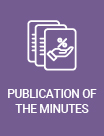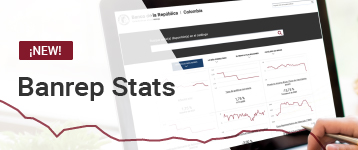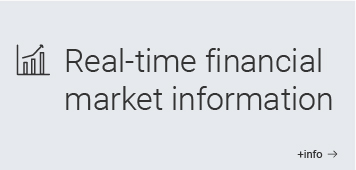Minutes of the Banco de la República Board of Director’s meeting on February 28, 2014
A regular meeting of the Board of Directors of Banco de la República was held in the city of Bogotá D.C. on February 28, 2014. In attendance were Mr. Mauricio Cárdenas Santamaría, Minister of Finance and Public Credit, Mr. José Darío Uribe Escobar, Governor and Managing Director of Banco de la República, and the Board Members Carlos Gustavo Cano Sanz, Ana Fernanda Maiguashca Olano, Adolfo Enrique Meisel Roca, César Vallejo Mejía and Juan Pablo Zárate Perdomo. These minutes contain a summary of inflation, economic growth and their prospects for the future, which was prepared by the Bank’s technical staff (Section 1), in addition to a review of the key deliberations and policy options considered by the Board of Directors (Section 2).
1. INFLATION AND ECONOMIC GROWTH
a. Recent Developments in Inflation
In January, annual consumer inflation (2.13%) registered a surge of 19 basis points (bp) compared to what was registered in December. A rise in both the annual change in food prices (1.2% annually) and in the prices of the basket excluding food (2.5% annually) were seen.
In the basket for food, the annual variation was 1.20% at the end of the month or 34 bp higher than in December. The surge was concentrated in the prices of perishable food (from -0.2% to 2.1% annually). The adjustment in the prices for processed foods, in turn, (-0.2% annually) stayed in negative territory with no significant changes while the meals away from home component remained stable (3.3% annually).
The main upward pressures in the CPI excluding food came from the groups of regulated items and tradables. In the regulated prices (1.7% annually) a rise of 61 bp was registered in the annual variation in comparison to the previous month.
The rise in the price for fuel in January after 5 consecutive months of negative adjustments is the most notable. There was a large adjustment, likewise, in the prices for public transportation resulting from the changes in fees for Bogota. The annual change in the CPI for tradables excluding food and regulated prices, in turn, went from 1.4% in December to 1.6% in January. This could be due to the recent behavior of the exchange rate.
In January, the annual change in the CPI for non-tradables excluding food and regulated prices (3.6% annually) showed a 15 bp decline, which is the lowest level since June 2012. The behavior of this indicator would suggest very low demand pressure on the consumer prices at the beginning of the year. In the case of rent, the annual change continued to fall very slowly and was at 3.5%.
The average of the four indicators of core inflation monitored by the Banco de la República was 2.55% in January, 5 bp higher than the previous month. This measurement has shown few changes since the beginning of 2013 and has fluctuated around 2.5%.
The annual change in the PPI climbed 72 bp in January and was in positive territory (0.2%) for the first time since September 2012. To a large degree, this change in the trend could be related to the depreciation of the peso and has occurred mainly in the import PPI (the annual change was a 121 bp rise in January compared to December). However, there was also a surge in the PPI for locally produced and consumed goods (the annual change was a 61 bp rise last month).
In January, the different measurements of inflation expectations stayed close to 3.0%. The figure derived from the monthly survey of financial market analysts was 2.9% for a horizon of 12 months from now and 2.8% for December 2014. The expectations derived from the TES curve yield for 2-, 3-, and 5-year maturities rose in January and over the course of February (on average) and are around 3.0%.
b. Growth
Recent information for the last quarter of 2013 indicates that productive activity expanded at a rate that was below what was registered for the third quarter. Nonetheless, this is expected to be above the average for the first half of the year. Although the situation indicators available for January 2014 are still very limited, they suggest that that performance has continued.
For December 2013, according to the Monthly Retail Sample index (MMCM in Spanish) published by DANE, retail sales grew 4.1% annually, a record that is lower than what was reported during the previous two months. However, the average of this indicator for the fourth quarter rose 5% compared to the same period in 2012. This figure is close to what was seen for the third quarter (4.9%). When vehicle sales are discounted, growth in December was 4.6% while the average for the fourth quarter went to a rate of 5.7%. This last figure represents a jump with respect to the figure registered in the third quarter (4.0%). Furthermore, in December, the sales balance from the Banco de la Republica’s Monthly Survey of Economic Expectations (EMEE in Spanish) also suggests that the expansion of household domestic consumption in the fourth quarter will have occurred at a rate similar to what was registered in the third.
Respecting investment other than investing in the construction of buildings and public works, both the balance of the EMEE investment expectations and the growth in imports of capital goods in real terms indicate a better performance than what was registered in the third quarter of 2013. In the first case, there is a recovery in terms of the balance sheet with respect to that registered in the third quarter. In the second, expansion in the fourth quarter was 8.5%, which was well above the 2.1% average registered in the third quarter.
Regarding foreign trade, total exports in dollars rose 6.5% in December due to the combined increase from mining (3.6%), agriculture (18.4%), and the remaining exports (5.5%). The increase in mining exports resulted from higher foreign sales of coal (36.2%) and crude oil (7.2%). In the case of agriculture, growth in coffee (16.9%), bananas (21.3%), and flowers (18.6%) was registered. Exports of industrial goods and others also rose 5.5% largely due to the growth in the area of food and beverages, vehicles and automotive parts, and chemical products that offset the drop in clothing, machinery, and electrical appliances.
Total exports in dollars for all of 2013 fell 2.2% with respect to the year before. This drop, which was mainly associated with lower prices, was due to the lower sales of mining (-3.6%) and agricultural (-0.5%) products. With respect to exports of industrial goods and others, there was a rise of 2.2%.
In December, total imports in dollars, in turn, registered a growth of 8.6% in comparison to the same month the year before. This performance is basically explained by the larger purchases of capital goods (23%) linked to a rise in rolling stock. Imports of raw materials grew 1.2% and those for consumption showed a fall of 1%.
Throughout 2013, the total value of imports in dollars grew 0.5% compared to the previous year. This performance was due to the higher imports of consumer goods (1.5%) and raw materials (0.5%) and partly offset by the declines in the purchases of capital goods (-0.1%). In general, the low growth in imports was associated with lower prices.
With respect to supply, the industrial production index (IPI) excluding coffee threshing as measured by DANE grew 1.5% in December. In quarterly terms, the drop in the IPI excluding coffee threshing (-0.3%) during the October-December period in 2013 was offset by significant growth in coffee threshing (55%). As a result, the industry overall grew 1.0% in the fourth quarter of 2013 which implies a recovery after the negative record of 1.0% in the previous quarter.
Based on information from November regarding construction, licensing continued reporting an important performance as it grew 21.7%. The 12-month aggregate figure showed an expansion of 15%. Based on information from December, production and dispatch of cement grew 7.3% and 8.9% respectively thus conserving levels that are quite favorable and historically high. In comparison to the previous quarter, both the production (which went from 6.0% to 11.7%) and dispatches (they went from 7.1% to 9.9%) surged. The performance of said indicators suggests that the strength of the sector has continued.
The above makes it possible to have a forecast range for the growth of the GDP between 4.0% and 5.0% in the fourth quarter with 4.6% being the most probable figure. Household consumption will have grown at rates similar to its historical average. Investment will have risen the most. Exports will have surged but less strongly than imports. With respect to supply, the greatest growth will be seen in construction (buildings and public works) and agriculture. The mining sector will have slowed down and growth of industry (which includes coffee threshing) will have been almost zero. With this information, we calculate that the Colombian economy grew between 3.7% and 4.3% in 2013 with 4.1% as the most probable percentage.
Information for 2014 is still very scarce and preliminary. In the area of demand, the consumer confidence index (CCI) published by Fedesarrollo, which is highly correlated to private consumption rallied in January with respect to the levels from the previous quarter and was above its average for all of 2013. The expectations component continues to show significant strength which may indicate a favorable performance for this area in the future.
For indicators in the area of supply, the Fedesarrollo opinion survey of business owners shows that the sales order indicator maintained its level in January and its trend continued rising but at a slower pace. The inventory indicator improved with respect to the previous month. Last of all, expectations for production in three months rose significantly and the trend showed a positive slope. As a result, industrialist confidence has improved in comparison to the two previous months.
In the case of commerce, the Fedesarrollo survey arrived at results for the current perception of sales that were quite positive. In it, the trend of the series showed a positive slope that would indicate that the performance of sales would continue to show the strength registered in the last few months. The outlook at six months, in turn, did not show significant changes and stayed at levels similar to those from the last two months. In spite of that, the current values are relatively high compared to the historical average for the series.
Other indicators with information as of January available are: i) the total demand for electricity, which rose 2.9% annually, expanded at every level and its trend shows a positive slope; ii) petroleum production was one million fourteen thousand barrels daily on average which, although it shows a low growth of 0.3%, implies an increase compared to the last four months.
Thus, for all of 2014 the growth forecast remains within a range of 3.3% to 5.3% with 4.3% being the most probable figure.
c. Financial Variables
Bank loans (N/C and F/C) registered an annual growth rate of 12.2% in January, which is similar to the level seen the previous month. The loan portfolio in national currency went up slightly from 12.9% in December to 13.0% in January while the one in foreign currency slowed down as it went from an annual growth rate of 1.5% to 0.4%.
Broken down by market, the portfolio of loans granted to households had an annual growth of 13.5% in January, slightly higher than what was registered in the previous month (13.2%). This was due to the performance of consumer loans, which increased marginally between December and January (from 11.95% to 12.05%). In the case of mortgages, the growth rate registered an uptick as it went from growing at a rate of 15.37% to 15.59% during the same period. Regarding the commercial loan portfolio, the annual growth rate in January (11.51%) was similar to the one in the previous month (11.55%). This was due to the upsurge in the national currency component (from 12.76% in December to 12.92% in January) and the slowdown in the foreign currency component (from 1.30% to -0.04%).
The interest rates for the loans disbursed by credit establishments since the beginning of the cuts in the benchmark rate in July 2012 have accumulated reductions of -213 bp for mortgages, -144 bp for consumer loans, and -236 bp for construction loans.
The size of the decline in the real interest rates has been lower due to the effect of the lower inflation rate. There have been reductions during the same period of: -182 bp for mortgage loans, -114 bp for consumer loans, and -205 bp for construction loans.
The levels of real interest rates for consumer loans, mortgages, preferential loans, ordinary commercial ones and commercial lines of credit as well as loans for construction in September were below their historical averages as calculated since 2000. In contrast, the credit card loans are above their average.
d. Foreign Context
Based on the figures for the fourth quarter, the GDP of the major developed economies continued to expand at a modest pace though with a slight uptick in the case of the Euro zone and the United Kingdom. The growth in some emerging economies, in turn, slowed down with respect to what was registered in 2012.
In the United States, preliminary data for the fourth quarter of 2013 show positive growth led by private consumption and exports. However, the initial figures disclosed for productive activity (industries and retail sales) in January 2014 revealed a slowdown in the rate of annual expansion and registered monthly declines. It is noteworthy that these figures may be affected by the severe winter season early in the year and, therefore, the activity could be expected to spike in the coming months. For example, preliminary data for manufacturing suggest somewhat of a recovery in February. In this context, several analysts have lowered their growth forecast for the first quarter but have left their forecast for all of 2014 unchanged.
In the euro zone, there was an upswing in growth during the fourth quarter because of the better performance in Germany and France and the end of the recession in some economies on the periphery. The figures for January show that consumer confidence continued to recover while, in the case of businessmen, confidence remained at a favorable level. Likewise, the indicators of business perception in the sectors of manufacturing and services remained in expansionary territory. With respect to the emerging economies in Latin America, the data as of December 2013 show that productive activity continued to slow down in Brazil and Chile while it was stable in Peru, and registered a slight increase in Mexico. Partial information for the beginning of the year shows some deterioration in the confidence of the agents in several of the economies in the region.
In China, the manufacturing activity continued to slow down in January while exports, in contrast, registered an upswing.
With regard to the international prices of commodities exported by Colombia, the prices for petroleum (benchmark Brent), coal, and nickel have remained relatively stable in recent weeks. The price of coffee, in turn, has risen due to the drought in Brazil. The adverse weather conditions in this country have also affected the prices of other food items such as soybeans.
In the case of inflation, the price fluctuations in the main developed economies in January remained below the long term targets set by their central banks. In Japan, the upward trend registered since last year has continued.
Given this situation and with output gaps that are still largely negative, the major central banks maintained their policies of monetary stimulus. However, another cut in monthly purchases of assets beginning in February was announced in the United States. In addition, based on the most recent minutes of the FED meetings, some members have begun to think that the increase in the benchmark interest rate could take place even before mid-2015 if the economic conditions continue to follow expectations.
Regarding the emerging economies, the inflation outlook is still varied with some recovery in Latin America and inflation that remains high in some countries in the region (Brazil, Argentina and Venezuela) and of Asia.
In relation to the financial markets, an increase in global uncertainty, particularly in some emerging economies, was observed in January. The ongoing tapering off of the stimulus program in the U.S. and the reduction in the growth projections in emerging countries as well as some political events that have occurred in them have increased the perception of risk for these economies. As a result, their currencies have depreciated and their stock markets underwent devaluations. The situation has shown a tendency to return to normal conditions in recent weeks. It is worth noting that the countries most affected by global uncertainty were those with greater external vulnerabilities and fewer possibilities for implementing stimulus policies.
In summary, the outlook for global growth in 2014 remains largely unchanged. Worldwide growth is projected to be just over half a percentage point higher in 2014 than what was registered in 2013. In 2014, the average growth for Colombia's trading partners will be above that recorded in 2013.
2. DISCUSSION AND POLICY OPTIONS
The board of directors took the following relevant aspects into consideration:
(i) There are no major changes in the outlook for worldwide growth in 2014 with respect to the ones described in the recently published Inflation Report. Worldwide growth in 2014 is projected to surpass that of 2013 by a little more than half a percentage point. The gradual recovery of the advanced economies continues and the new data from emerging countries has confirmed the expected slowdown in their growth rate. For 2014, the average growth for Colombia’s trading partners will be above that registered in 2013.
(ii) Foreign interest rates and the price of the dollar are surpassing the averages seen in 2013. It is likely that a significant part of these increases will be permanent to the degree that they are due to less expansionary global levels of liquidity.
(iii) The international price for petroleum remains at high levels and the price for Colombian coffee has surpassed the average registered for 2013. The prices for coal and nickel stopped falling. Therefore, it is likely that the terms of trade will remain at favorable levels.
(iv) The technical team predicts that economic growth for the fourth quarter of 2013 will be between 4% and 5% with 4.6% being the most probable percentage. Household consumption will have grown at rates similar to its historical average. Investment will have shown the highest rise. Exports will have surged but not as strongly as imports. In the area of supply, construction (buildings and public works) and agriculture will have presented the most growth. The mining sector will have slowed down and growth of industry (which includes coffee bean threshing) will have been almost zero. Based on this information, the Colombian economy is calculated to have grown between 3.7% and 4.3% in 2013 with 4.1% as the most probable figure.
(v) Economic growth is projected to be between 3.3% and 5.3% in 2014 with 4.3% being the most probable percentage.
(vi) In January, the total growth of loans slowed down although it is still at rates that are higher than the rise in the nominal GDP. The nominal interest rates for loans increased, but in real terms, they remained stable and are at levels that drive economic growth.
(vii) Annual inflation in January was 2.13% and thus within the target range. Furthermore, the average of the core inflation measurements was 2.55%. The inflation expectations of economic analysts for a year from now as well as those derived from public debt paper with maturities of less than five years are around 3%.
The members of the Board of Directors emphasized that the information available on the internal variables of demand, confidence, output growth, loans, and inflation indicates that the output gap and the current deviation of actual inflation from the target (inflation gap) have been closing and this is expected to continue over the course of the year.
They reiterated the uncertainty about the effect that the gradual normalization of monetary policy by the United States Federal Reserve could have on the Colombian economy through contagion from emerging countries that are more vulnerable. They also highlighted other risks, especially those from the situation in Venezuela; the slow down in the growth of economic activity in China and the recent performance of some indicators associated with the rate of expansion of the North American economy. They also commented that in spite of the fact that inflation for food continues to remain very low compared to historical records, this behavior is partly due to transitory factors and could reverse itself if the trend in the international prices for food changes.
To the Board of Directors, the forecast of a gradual convergence of inflation towards its target and of output towards its potential value together with the risks noted above suggested that it would be prudent to maintain the current expansionary monetary policy posture.
3. POLICY DECISION
The Board of Directors agreed unanimously that it would be appropriate to keep the benchmark interest rate at 3.25%.
The Board will continue to monitor the performance and projections for economic activity and inflation in the country, the asset markets, and international situation carefully. Finally, they reiterate that the monetary policy will depend on the information available.














.png)

































